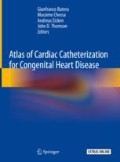Abstract
Pulmonary arterial branch stenosis may occur congenitally or after surgical procedures. Newborns and adults with congenital heart disease may be affected. All sections of the pulmonary arterial tree may be involved: the main pulmonary artery or its origin, the central branch pulmonary arteries, and the segmental pulmonary arteries. In newborns and young infants with pulmonary arterial stenosis after surgical procedures involving the pulmonary arteries, balloon angioplasty may be employed as first-line treatment, if repeated surgery does not seem adequate. In these small patients, large stents dilatable to adult size vessel diameter cannot be implanted since large stents on large balloons need large introduction sheaths. However, balloon angioplasty may not always lead to an acceptable flow increase of the stenotic lung segment and even in this difficult patient group stent implantation may be the only solution. In general, stent implantation is the preferred first-line treatment in patients with pulmonary arterial stenosis, in whom a stent can be implanted, which can be expanded to an adult size diameter though.
Access this chapter
Tax calculation will be finalised at checkout
Purchases are for personal use only
Author information
Authors and Affiliations
Corresponding author
Editor information
Editors and Affiliations
1 Electronic Supplementary Material
Cyanotic newborn (50 cm, 2,8 kg) 8 days after a Norwood-Sano operation (5 mm RV-PA shunt), ventilated with 100% oxygen. Arterial oxygen saturation <65%. Angiography shows a severe distal stenosis of the Sano shunt involving both pulmonary arteries (WMV 2075 kb)
Cyanotic newborn (50 cm, 2,8 kg) 8 days after a Norwood-Sano operation (5 mm RV-PA shunt), ventilated with 100% oxygen. Arterial oxygen saturation < 65%. Angiography shows a severe distal stenosis of the Sano shunt involving both pulmonary arteries (WMV 1881 kb)
Final result with unobstructed flow to both pulmonary arteries. Arterial oxygen saturation rose from <65% to >75%. A Y-stent configuration of the pulmonary bifurcation was created (WMV 2097 kb)
Final result with unobstructed flow to both pulmonary arteries. Arterial oxygen saturation rose from <65% to >75%. A Y-stent configuration of the pulmonary bifurcation was created (WMV 2063 kb)
One year old child with common arterial trunk 6 months after implantation of a 14 mm Contegra graft (RV-PA) now with RVP 88/0/12, PAS 20/13/15, PAD 21/12/14, AoP 105/46/66 (RVP:AoP ratio 88%) (WMV 1550 kb)
One year old child with common arterial trunk 6 months after implantation of a 14 mm Contegra graft (RV-PA) now with RVP 88/0/12, PAS 20/13/15, PAD 21/12/14, AoP 105/46/66 (RVP:AoP ratio 88%) (WMV 1353 kb)
Two 6F Terumo 45 cm long sheaths (via both femoral veins) were advanced on 0.035′ guidewires into the right ventricular outflow tract. A 6 × 12 mm Formula™ 535 stent was positioned into the origin of the right pulmonary artery and a 8 × 12 mm Formula™ 535 into the origin of the left pulmonary artery. The stents were inflated simultaneously (WMV 972 kb)
Two 6F Terumo 45 cm long sheaths (via both femoral veins) were advanced on 0.035′ guidewires into the right ventricular outflow tract. A 6 × 12 mm Formula™ 535 stent was positioned into the origin of the right pulmonary artery and a 8 × 12 mm Formula™ 535 into the origin of the left pulmonary artery. The stents were inflated simultaneously (WMV 5469 kb)
Two 6F Terumo 45 cm long sheaths (via both femoral veins) were advanced on 0.035′ guidewires into the right ventricular outflow tract. A 6 × 12 mm Formula™ 535 stent was positioned into the origin of the right pulmonary artery and a 8 × 12 mm Formula™ 535 into the origin of the left pulmonary artery. The stents were inflated simultaneously (WMV 1244 kb)
Result after inflation of both stents. RVP was 58/2/16, PAD 29/14/16, AoP 119/54/67 (RVP:AoP ratio 48%) (WMV 1356 kb)
Rights and permissions
Copyright information
© 2019 Springer International Publishing AG, part of Springer Nature
About this chapter
Cite this chapter
Eicken, A., Ewert, P. (2019). Stent Implantation in Patients with Pulmonary Arterial Stenosis. In: Butera, G., Chessa, M., Eicken, A., Thomson, J.D. (eds) Atlas of Cardiac Catheterization for Congenital Heart Disease. Springer, Cham. https://doi.org/10.1007/978-3-319-72443-0_13
Download citation
DOI: https://doi.org/10.1007/978-3-319-72443-0_13
Published:
Publisher Name: Springer, Cham
Print ISBN: 978-3-319-72442-3
Online ISBN: 978-3-319-72443-0
eBook Packages: MedicineMedicine (R0)

